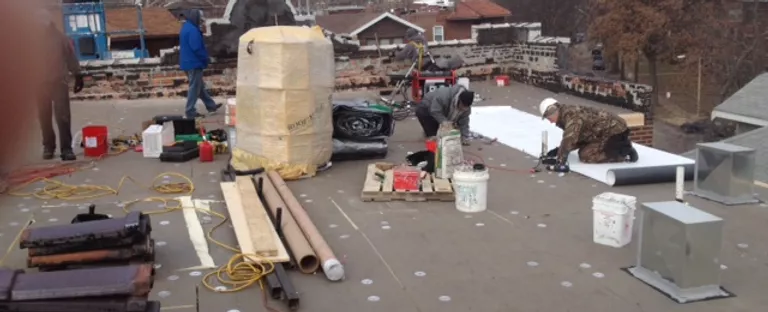 Are you looking for a quality, energy efficient solution for a low slope roof and are not sure whether to go for a TPO or an EPDM rubber roofing membrane? It can be difficult to distinguish between the two products, as both are single ply roofing membranes.
Are you looking for a quality, energy efficient solution for a low slope roof and are not sure whether to go for a TPO or an EPDM rubber roofing membrane? It can be difficult to distinguish between the two products, as both are single ply roofing membranes.
However, there are important differences that you need to be aware of to figure out which roofing membrane is right for you. When making your decision, consider such factors as cost, longevity, durability, maintenance, ease of installation and energy efficiency.
Cost
EPDM roofs are the most economical choice for single ply roofing membranes. TPO roofing membranes are more expensive than EPDM. Regardless of which membrane you choose, it is better to spend more money and invest into a thicker membrane. Both EPDM and TPO roofs perform better and last longer if they are thicker. Both of these types of roofing systems can be installed on both commercial and residential flat roofing applications.
Longevity
By far the most important aspect that will determine the longevity of a single ply roofing membrane is the method by which the overlapping seams have been attached together. Permanently attached seams are the safest solution, and improper attachment can be the cause of 99% of leaks.
It is difficult to determine the longevity of TPO roofing membranes for a couple of reasons. First, this is a fairly new roofing product, there are no TPO membranes in the US today that are older than 15 years. Second, TPO membranes continue to be an experimental products- they are all in their 2nd, 3rd and in some cases 4th generation of formulations, so it is not possible to definitively say how low any of these will last. Moreover, many TPO products have been pulled off the market in the past both for seam and material failures.
Durability
An EPDM roof has a solid reputation for durability. Made of rubber compound, EPDM roofs have been on the market for decades- having properly tapered seams and detailed flashings, an EPDM roof will last up to 25 years. It is recognized in the industry as a dependable roofing material that offers resistance against ultraviolet light, ozone, oxidants and severe weather conditions. An EPDM membrane will also preform better than TPO in colder climates.
TPO seam strength is 3 to 4 times that of EPDM adhesive and tape seams. TPO membranes are manufactured to be as durable as EPDM. However, because there are continuous changes and improvements to the formulation, different TPO membranes perform differently. TPO is known to respond poorly to ponding water (it splits and cracks) and also does not have strong resistance to heat and solar overload.
Maintenance
In the beginning of its service life, a properly installed EPDM membrane will not require much maintenance. However, unlike TPO ( which has hot-air welded seams) an EPDM’s seams are treated with an adhesive, making them ultimately vulnerable to coming apart. This means that in the long run an EPDM roof will require maintenance to keep in tact. Be aware that EPDM responds very poorly to any kind of solvents and oils. Therefore, you should not use cleaners or conditioners that contain petroleum solvents, harsh abrasives or Citric based cleaners as these may cause irreparable damage to an EPDM membrane.
TPO membranes are not as easy to maintain as EPDM roofing membranes. In general, it is problematic to weld new materials to a TPO membrane, because as compounds age they loose their pliability and their subsequent thermoplastic capabilities. Consequently, to effectively heat weld new material to an old membrane may require an an “activator” similar to hypalon to seal repairs.
Ease of Installation
An EPDM rubber roof is easier and faster to install than a TPO roofing membrane. EPDM requires no special equipment for installation while TPO needs to be hot air welded. This makes installing a TPO roofing membrane a more complex and costly process that also requires specialized knowledge. While a beginner roofing contractor will most likely be able to properly install an EPDM membrane, you should only hire an experienced contractor to install a TPO roof. Improper installation will invariably cause leaks and will require costly repairs or replacement. This can be costly and is why you should choose Tesson Roofing for your proper commercial roofing installation.
Energy Efficiency
TPO membranes have become an increasingly popular single ply roofing choice because they offer energy efficiency. White TPO membranes are considered to be a “cool” roofing technology, but other colors of TPO are also formulated to have sun reflective properties. With a TPO roof, it is possible to save money on cooling costs of both residential and commercial properties. By reflecting solar heat, a TPO roof is able to maintain a cooler thermal balance inside the space, reducing the need for additional air conditioning. Energy efficiency makes TPO roofs particularly popular in hot sunny regions that get a lot of cooling days.
While EPDM roofing membranes are also available in white and will offer better reflective properties than darker colored EPDM, an EPDM roof will not offer the same level of energy and financial savings as a TPO roof.
